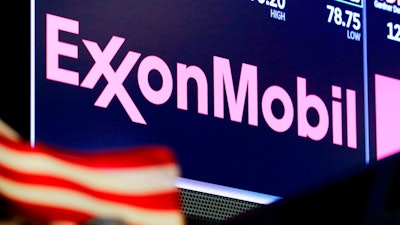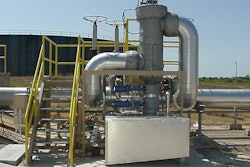
NEW YORK (AP) — The Houston Ship Channel is home to petrochemical plants, power companies and heavy industries, all of which throw climate-harming emissions into the air.
In a process called “carbon capture and storage” (CCS), some industrial facilities capture this carbon dioxide before it leaves their plants, and then use it to develop products or store it underground.
Now Exxon Mobil has suggested turning the 50-mile-long channel into a CCS hub. The oil and gas giant is calling on industry and government to jointly raise $100 billion to create infrastructure to capture carbon dioxide at industrial plants, carry it away in pipelines and inject it deep under the floor of the Gulf of Mexico.
Joe Blommaert, President of Low Carbon Solutions at Exxon, says CCS is essential to meeting the goals of the Paris agreement while also meeting the growing energy needs of the world. Exxon has raked in more than $20 billion annually in profits over the past decade, on average, and nearly $300 billion annually in revenues. Blommaert talked with The Associated Press about the $3 billion that Exxon plans to spend on the business through 2025, and how the project might take shape. The interview has been edited for length and clarity.
Q: Your vision for the Houston Ship Channel calls for a $100 billion investment from companies and government. That’s a lot of money. How do you envision it would be spent?
A: Obviously, the scale is unprecedented. When you look into the details, actually, it is many capture facilities and storage facilities, and actually this CCS is executed at scale already around the world. What is important in my mind is this collaboration of the whole industry, the whole of government and the whole of society. And it is actually addressing climate change, which technically is a very complicated issue. It needs all of the solutions, and it is not one or the other. And that’s why with the Houston Hub we were so pleased with the 10 companies willing to step forward to help make this a reality.
Q: How much is Exxon willing to invest?
A: We are, just like other companies, assessing those opportunities. We’re working through our project and definition, and we will certainly do our part. I will not quote a specific number. We are working through that, as you can imagine. But the key is that policy to attract public and private investment in supporting this is put in place. And that’s why we talk about the value of carbon, which is essential.
Q: Can you tell me what percentage of the Houston Ship Channel project costs Exxon would likely contribute?
A: I will not give you the percentage, it’s obviously too early. Actually a meeting is scheduled in the next few days to talk about how to get organized, do governance, and so on. And then each company is actually looking at its own capture project, if you will, and the specific details. So more to come on that.
Q: Was this plan created in response to investor concerns about climate change?
A: We started this CCS venture about three years ago and actually that is now included in my business. And so we brought that to a stage that we could start thinking about how to really bring that to scale.
This was actually already quite quite well progressed, culminating in the creation of a (carbon capture) business that is now 30 this year, and we already had a portfolio of ideas. It’s just the right time for us.
Q: If Exxon believes this is important, why not dramatically reduce oil and gas production and invest more in renewable energy?
A: I fully appreciate this perspective on the issue, and I would come back to what I said earlier in terms of meeting the goals of the Paris accord and meeting energy and product demands that modern life requires, particularly when you think about the growth of society, 2 billion more people by 2050.
That energy mix will change, but that will still require energy sources from fossil fuels. That’s why it is actually so important to have technologies like CCS so that you can meet the energy supplies that the world needs in a way that the emissions are being abated, and that you can do that at the lowest cost possible to society. And you can do that now.
We’re buying renewable power. We do that through our power purchase agreements. We believe our strength really comes to the forefront through the deployment of technologies like CCS, like hydrogen, like biofuels. And those are technologies that are being recognized by the Intergovernmental Panel on Climate Change and the International Energy Agency as technologies that society needs to meet modern life requirements.






















